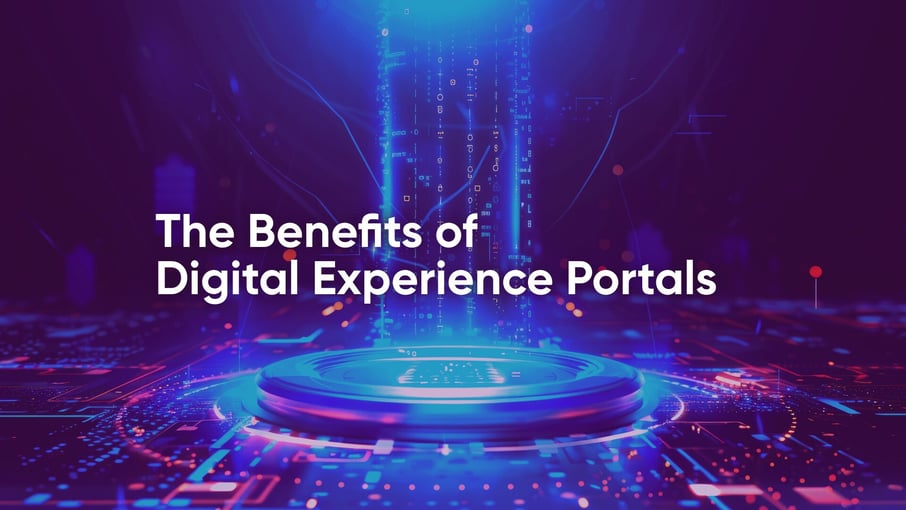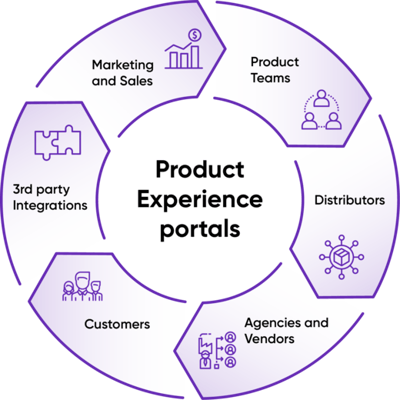
Organizations have realized that if customers are to be kept engaged and serviced well, it must be on their terms. That’s because customer satisfaction is no longer a one-time thing; enterprises have started investing in building lifetime loyalty through delivering exceptional web and mobile experiences at every stage of the customer lifecycle. They have also realized that existing customers are crucial for growth and keeping revenue streams alive. That is why digital experience portals can be seen as key to providing secure, super-efficient, self-service work scenarios to help companies deliver nothing but the best, thereby improving customer retention and experience. This insight closely examines how digital experience portals are proving to be advantageous to both customers and businesses alike.
What is an Experience Portal?
An experience portal can be defined as a single point of access for the unification, organization, communication, and dissemination of organizational knowledge and the creation of strategies to advance as well as improve business practices. In other words, experience portals offer a means to synchronize meaningful information and applications to create a single, comprehensive view of an organization’s existing knowledge and intelligence.
What is a Product Experience Portal?
A Product Experience Portal is a consumer-facing portal that provides a means for customers to access up-to-the-minute product information and digital assets information. Product experience portals are a broad term that includes digital asset experience and user experience and are powered by a portal engine. In essence, a product experience portal is an application that utilizes standard functionalities and offers a clean, personalized, secure log-in environment to users for viewing and managing their product information and digital assets. In addition, product portals also provide the structure and navigation to handle the data pools within the portal.

Why are Product Experience Portals Needed?
Due to the growing presence of product experience portals, users are increasingly turning to self-service and are getting used to the flexibility of any-time, anywhere online interactions. The control that comes with it is leaving them more fulfilled and satisfied than ever before. From a user experience standpoint, portals are considered to be the perfect solution to complicated processes often involving too many people and inflexible means to send and receive information. A product portal presents a clear, unbiased picture of products to all parties involved, displaying a comprehensive, 360-degree view of the situation in the most accurate form and format.
In the absence of a portal, a user who wants to check the status of their service request or check the visibility of their order will have to depend on different siloed tools or apps for every activity. What complicates matters further is that organizations try to offer a high degree of personalization in siloed apps to offer enhanced experiences. However, due to being disconnected, users’ data have gaps and disparities.
In comparison to this, product portals provide a smooth, integrated, enterprise-wide portal experience by offering complete and transparent information.
Main Benefits of a Product Experience Portals
A product portal offers a flexible, configurable, dynamic, and personalized view to enable internal and external business users. By providing capabilities such as advanced product search, intelligent insights, and advanced analytics, a product experience portal helps businesses hand over the control to users. Apart from the benefits listed below, product experience portals’ core strength is the empowerment it offers users in exercising complete control over products.
1. Enhancing Customer Experience via Personalization
A personalized experience signifies that every single visitor gets their own dashboard based on their profile, specific requirements, previous purchases, products ordered, features used, preferred navigation, workflow and a personalized access to information and applications. One of the main advantages of portals is the personalization of databases, data warehouses, metadata, and accessibility of systems and technologies.
2. Manage Cross-channel Services from a Single Platform
To match customers’ preferences of using more than a couple of channels to communicate with product suppliers, modern-day portals offer a single point of control to access various communication channels. This helps customers manage and organize product data flexibly, navigate across channels, and create engaging and scalable experiences while simultaneously optimizing their go-to-market strategy.
3. Lower Total Cost of Ownership
Unlike traditional portals that involve multiple integrations leading to higher license and maintenance fees, experience portals provide an integrated set of capabilities at a much lower cost. Also, due to the involvement of fewer resources, portals help bring down the operational costs while eliminating multiple hidden costs (such as separate support costs).
4. Decreased Time-to-market and Application Development costs
By drastically speeding up the processes and due to reduced human intervention, portals cut down on unnecessary activities and measures and get the product straight to the market. Similarly, the cost of developing multiple applications is eliminated as a single product portal can handle all the requirements. Therefore, no separate teams, no separate projects, and no separate upgrades are needed.
5. Flexible deployment
Deployment is faster and highly flexible due to greater control at source. Monitoring of the setup is easy. Integration can be continuous; it facilitates relentless improvement, fosters innovation, and results in high-quality project management. Deploying microservices is easier for users as individual scalability and release management can be easily handled.
6. Improve Success ratio with Self-service
Business agility is highly dependent on self-service tools for effective change management, business autonomy, claim management, automating decision rules, facilitating higher rate of loyalty, and addressing digital business imperatives. Self-service options offer automated services by engaging customers in newer ways via utilizing various existing touchpoints.
7. Enhanced Business Intelligence
Product portals collect an extensive amount of data, which comes from different applications and sources. They can record minute details, which helps in creating fully customizable web-based reports to serve as a source of business intelligence. As customer experience and interaction gets tracked at every step, portals offer a holistic understanding of any bottlenecks or improvements.
8. High degree of Reliability
Product experience portals are designed to cater to the most stringent performance requirements, including fulfilling a variety of mission critical business needs and users’ demands, ensuring lower dependencies, maximizing campaigns’ continuity, and offering a failsafe environment for every party involved. It makes sure that product experience portals stay highly reliable.
How Product Experience Portal Works?
Creating a smooth, integrated product experience for users begins by treating product experiences as an enterprise-wide phenomenon rather than a mere technology implementation. The first step is to determine appropriate processes and resources by bridging internal organizational silos and establishing collaboration which might include redesigning operations and aligning various resources and processes in the organization to turn various teams into a cohesive, cross-functional unit. This way, portal management becomes associated with the organizational mission, which is customer-focused instead of a having narrow departmental focus.
The next step is transforming the product portal experience via superior user management, including creating group enrollment and permissions, and handing users a single, permanent identity throughout all touchpoints. Identity management is another essential aspect, wherein the foundational element is smooth onboarding and offboarding, proper classification, approvals, superior governance, and compliance.
A few approaches to drive portal organization are:
- Customer dashboards: This is where customers land on a dashboard the moment they log into an enterprise portal. The customer gets a single-sign-on (SSO).
- Portal containers: This approach involves creating portal containers, where shared navigation and some bit of theme management can help create an end-to-end experience.
- Experience centric: Some businesses treat experiences as their core offering, so they provide custom frontends to offer fast and agile customer experiences.
- Cross-sectional: A platform that combines a modern portal but also includes the capabilities of their legacy platform to offer the best of both elements.
.png?width=650&height=121&name=Insight_The%20Benefits%20of%20Digital%20Experience%20Portals_R1-03%20(1).png)
Due to several inbuilt features, product experience portals provide a range of digital solutions beneficial for all partners involved. They include a superior level of personalization, customization, content management, searchability, scalability, collaboration, and integration while offering an advanced level of business intelligence, task innovation, accessibility, and administrative tools.
1. Collection and Standardization
Product data is collected from different locations (including both internal and external ones); users have the ability to create an unlimited number of collections and build a personalized and flexible segmentation layer over the products. This is followed by standardizing the data from various formats into a single format by creating common product attribute names and categories.
2. Product Data Viewing
Product data portals offer users a highly configurable, detailed view of products, driven by a robust UI. They provide users with plenty of attributes, related products, and assets that can be used in a highly user-friendly manner. It also provides auditable versioning information, and a feature to compare product information while offering options for sharing and downloading.
3. Aids Marketing and Sales
The product experience portal acts as a hub for marketing and sales content. Product marketers are interested in eliminating errors related to consistency; they need faster processing, higher efficiency, and accuracy. Product portals act not only as marketing databases but also as engines for information procurement, marketing automation, and to manage data dynamically. This helps marketing teams with shorter marketing cycles and increased control.
4. Product Data Search
Product data search is one of the strongest features of product portals. It allows business users to find the correct information for uninterrupted enterprise productivity. Tools like auto-suggest saved searches, auto suggestions, and customizable search refining filters makes looking for products an incredibly efficient feature. Also, the capability lets users to conduct highly detailed searches to retrieve product information and digital assets.
Pimcore Use Case
Pimcore created a B2B Commerce portal for a Global food and beverage giant in multiple regions like China, Latin America, and Australia
The organization wanted to improve agility, efficiency, and reduce costs in their product distribution by eliminating manual product ordering processes that used spreadsheets (which was time-consuming and error-prone) and boost B2B sales across countries.
They also had a lengthy and complicated B2B ordering process for buying products. Inflexible excel templates were making it all the more difficult, and there were no provisions to offer suggestions of related products to B2B buyers.
Due to this, order placement took extensive effort, product visibility became limited, and the entire process became complex and slower; at the same time, opportunities to cross-sell and up-sell could not be leveraged. Besides, it was getting increasingly complicated and inconvenient for distributors to make the most of the available offers.
Pimcore built a B2B e-commerce portal to offer region-specific product visibility. The portal streamlined processes by integrating mobile ordering with social media and created API-based integration for predictive suggestions and in-context offerings.
The result was a high increase in efficiency, as thousands of distributors could place orders instantly, high growth in sales during peak times (close to $100M during the Chinese New Year), and enhanced customer experience to guide customers to what they want to buy.
The portal was then scaled up across the Latin American and Australian region to streamline product ordering by enabling personalization and real-time order fulfilment, which improved responsiveness, end-to-end customer experiences, order size, and consumer demands.